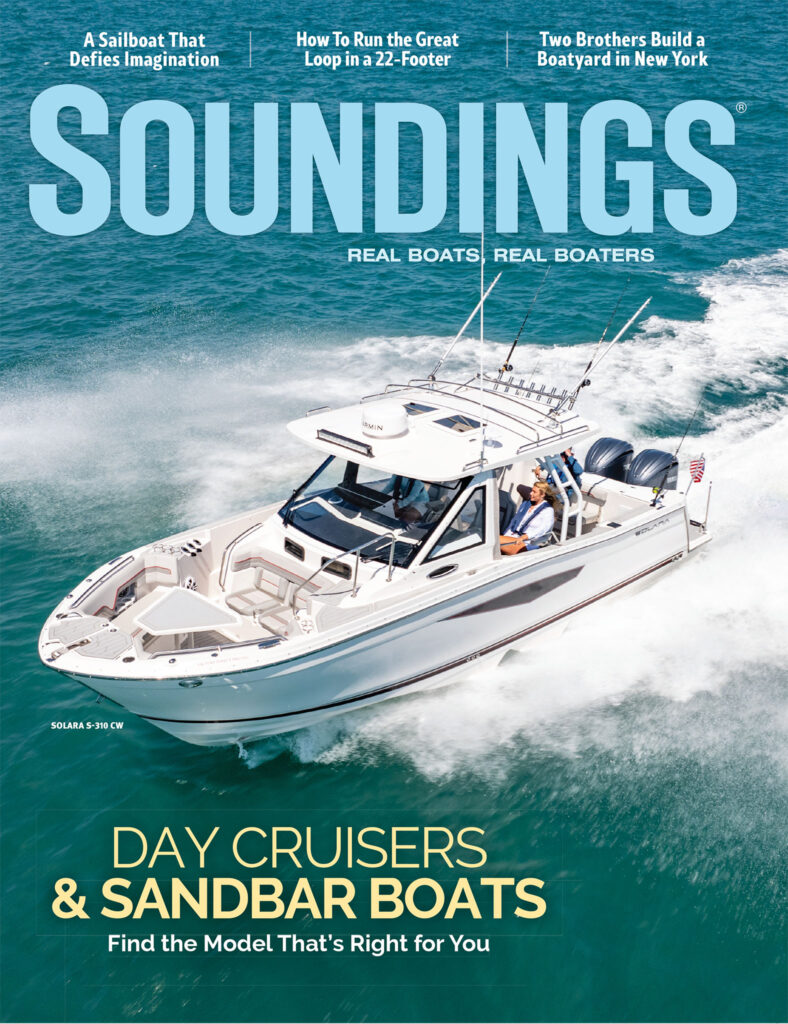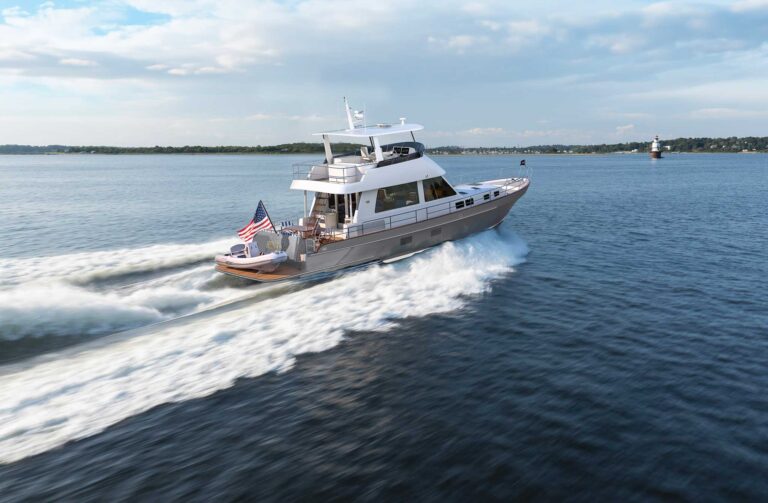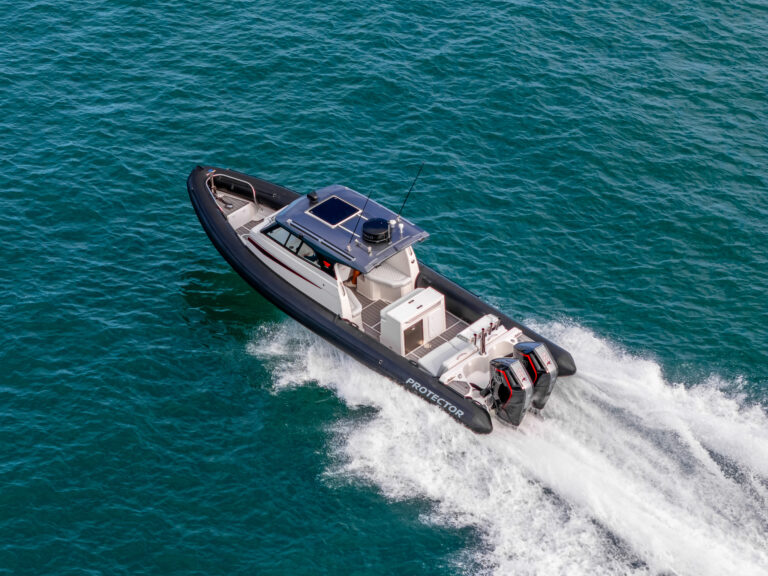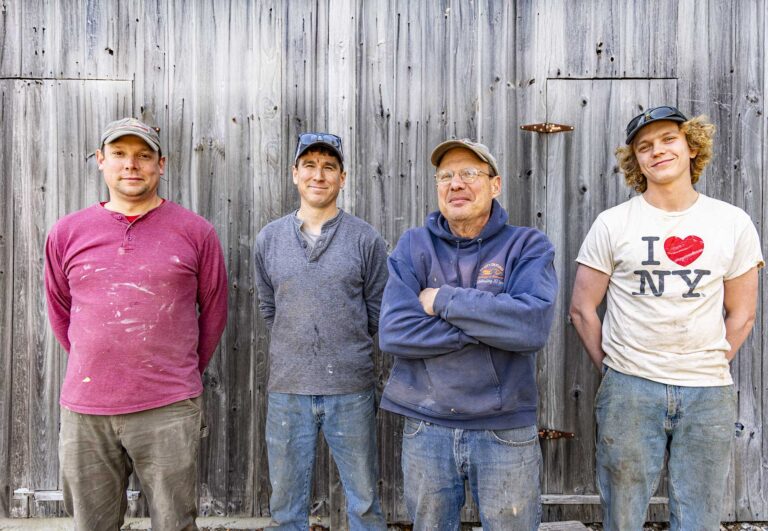Skeptics become believers
Power catamarans might not be
everyone’s cup of tea, and they’ve suffered their share of growing pains, but fans say all it takes is a ride to turn skeptics into believers
The tarpon were rolling in Government Cut as Scott Ellis pointed the 33-foot power catamaran out to sea. The breeze had freshened over the course of the day, and the choppy waters off Miami were suitable for putting the outboard-powered World Cat 33 through a battery of tests.
Ellis, a field service rep for World Class Catamarans of Tarboro, N.C., was on a mission to prove power cat critics wrong — critics who might agree that a cat can’t be beat running into a head sea but who are put off by how it acts in a turn or following sea, or by the so-called “sneezing” that occurs when spray is blown out of a cat’s tunnel and over the bow.
Cats take a lot of grief for behaving differently than monohulls and have a reputation for being complex, expensive and without the backing of major boatbuilders. Whether performance, perception or economics is to blame, power catamarans — both cruising and performance — remain a cottage industry within the U.S. pleasure boat market. Ellis and other catamaran boosters, however, want to change that.
Once in open water, Ellis’ first move was to put the cat’s twin hulls into a gentle turn to port. With a level stance, the World Cat made a wide arc. He then trimmed the starboard engine in, and the boat turned tighter, actually banking into the turn. “What you want the bow to do, you do to the opposite engine,” says Ellis.
Upon trimming in both engines, turning the wheel hard over and opening the throttles, he had the cat turning in tight circles like a vee-bottom boat. “The majority of the complaints you hear about are trim related,” says Ellis. “And it just takes [time] at the helm to get on top of everything.” For example, to counteract bow steering in a following sea, Ellis suggests trimming the engines out to move aft the sponsons’ point of entry. Trimming out at high speed also counteracts sneezing by getting the air to move through and out the aft end of the tunnel. Although sneezing may still occur at low speeds, Ellis suggests running at an angle to seas to avoid getting wet.
Like monohulls, cats are built with displacement, semidisplacement and planing hull forms, and Ellis and his co-workers credit World Cat’s semidisplacement design for its vee-like agility. But each power cat builder has its own way of saying that two hulls are better than one. And their method for getting that point across is the sea trial.
Get behind the helm
Each individual catamaran hull has a narrow beam-to-length ratio, which not only increases efficiency but reduces accelerations felt on board. “We’ve told all of our salespeople, ride them on a monohull first,” says Robbie Robinson, head of marketing for Pro Sports Boats of Riverside, Ala., which builds ProKat power cats from 20 to 37 feet. “I think once a person rides on a catamaran and compares it in the same seas, they can really see the difference.”
Russell Hunt, president of Multihull Development of Plymouth, Mass., agrees. “We push sea trials, sea trials, sea trials,” says Hunt, whose company tagline is “Run One.” Hunt says the “SeaDay,” or all-day sea trial, is his company’s biggest marketing tool.
While the handling under way might take some getting used to, the cat’s motion at rest is among its biggest selling points. “A monohull has a fulcrum in the middle of it,” says Robinson. “If you take a 200-pound guy and put him out on the gunwale, it’s going to sink to that side. A power cat, because it has two sponsons, it has more of a counterbalance.”
“You’ve got to compare it to a motorcycle and a car,” says World Cat regional manager Michael Hunt, with the motorcycle being a monohull and the car a cat.
The two hulls also are a boon for exploring shallower waters. “Catamarans actually [draw] a lot less than monohulls,” says Robinson. “To me, that’s a huge advantage of a cat over a deep-vee hull.”
However, cat owners have to carefully watch the weight of gear, equipment and passengers, as the narrower hulls are more susceptible to overloading. This can affect performance and increase the likelihood of bottoming out the tunnel in rough seas.
“A properly done, built, matched power cat can give you the best of what you’re looking for,” says Russel Hunt, who lists fuel efficiency, space on deck, shallow draft and excellent seakeeping among the cat’s favorable qualities.
And it isn’t hard to argue that those qualities should appeal to all boaters. “They [cats] are looked at as a niche boating market,” says Hunt. “But it’s not niche boaters that want a better ride, more fuel efficiency and more safety.” It’s most boaters, he argues.
Several of the builders we talked to believe that catamarans are more redundant and therefore safer than monohulls. “As far as safety goes, we look at it as a don’t-have-all-your-eggs-in-one-basket kind of thing,” says Hunt, whose company now offers an outboard version of its Buzzards Bay 33. The catamaran design splits the boat’s buoyancy needs over two hulls, he says, and lends itself to multiple bulkheads and compartments — call it “compartmentation” — and redundancy.
“You’re building two completely redundant engine rooms,” says Rob Poirier, head of sales and marketing for PDQ Yachts of Whitby, Ontario, which builds both power and sailing catamarans. The twin engines, one in each hull, offer the reassurance of twin rudders and twin fuel supplies. This redundancy, however, adds complexity and cost.
“Catamarans are harder to build,” says Poirier. The woodwork and molds are more complex, construction requires more man-hours, and the tooling can cost twice as much, he says. “You’re kind of building two boats at the same time.”
“Cats are not cheap on an LOA basis,” Maine Cat owner and designer Dick Vermeulen says in an e-mail to Soundings. “Most buyers don’t look at the square footage [compared to monohulls] or the redundancies of the systems, which add to the cost.”
Some monohulls require “corrective measures” such as bow thrusters, trim tabs and stabilizing systems, says Poirier. “From a purist’s point of view, this is a much more honest boat design that doesn’t demand correction,” he says.
Challenges
Bob Vincent, president of Endeavour Catamaran of Clearwater, Fla., which builds TrawlerCat powerboats and EndeavourCat sailboats, is among those who laud the catamaran’s ease of motion. “With a cat, it’s like standing on two feet instead of one,” says Vincent.
However, it takes a bit of effort to get those two feet to work together. “You’re working with two separate hulls, and there’s much less room for error there,” says David Watton, president of Defiant Catamarans of Sarasota, Fla., which builds a 27-foot outboard-powered cat, with a 23- and 45-footer on the way. “They are very, very touchy as far as getting them to work well. Also, you’re dealing with lower volume than other boatbuilders, so you have relatively low cash flow to devote to development.”
Twin Vee’s David East says it takes longer to bring a cat to production. “Cats are designed basically by the seat of your pants,” says the Fort Pierce, Fla., builder’s president. “If you want to design a monohull there’s umpteen programs out there and CAD-CAM to design your boat. [With catamarans] it’s all done by individual manufacturers, so there’s a lot of R&D to get one right.”
With qualities like seaworthiness, efficiency and safety, it would seem logical for major production boatbuilders to join the power cat fray. So far they haven’t. “Everybody’s still standing around the dance floor, waiting to see if there’s enough people dancing,” says Poirier. “Most of the major [cruising] power cat players came from the sailing catamaran side.”
East contends that one production builder discontinued its lone cat because it was outperforming its vee-hull designs. “That’s pretty much what kept the big boys off of us for years,” he says. “They could buy the technology, but it would obsolete these millions of dollars of vee-hull molds they have.”
Twin Vee is projecting to build 650 to 700 boats this year, while a big monohull builder might produce 4,000 boats. “Collectively, we don’t even match one vee-hull manufacturer,” says East of the power cat industry.
That relatively thin participation means fewer options for consumers. “The power cat market is still very young,” says Maine Cat’s Vermeulen. “Very limited offerings at this time, and a number do not stir your heart with joy from their sheer beauty.” He points to a lack of bluewater power cats, something the Bremen, Maine, builder hopes to counteract with its first power cat, the P-38, named after the Lockheed P-38 Lightning aircraft.
“There’s a lot of interest out there, but there needs to be some more upscale power cats,” says Mark Brunsvold, founder of Black Pearl Marine, a Wisconsin-based company that markets a high-end 46-foot sportfishing power cat. “Most of the stuff’s entry level.” The Brazil-built Black Pearl 46 was hit hard by high exchange rates, he says. The builder currently is building an 80-footer for a Brazilian client.
Even if construction, function and price fit a boaters’ needs, at the end of the day owners still want to enjoy looking at their boats. Aesthetics certainly have been a stumbling block for power cat builders.
“The biggest problem in the market is fashion,” says Poirier, who contrasts the power cat with a typical tug-style trawler and its attractive lines.
Pro Sports’ Robinson puts it bluntly: “Most people think catamarans are ugly,” he says.
To counter this perception, the builder brings its ProKats to a point at the bow. “A lot of your older fishermen are traditionalists,” says Robinson. “We did it on purpose to make a catamaran look like a regular vee hull … to make it look traditional.”
Boaters who have been planning a boat purchase for years, especially on the cruising side, have a picture in mind — and it’s usually not a catamaran.
“Until just recently, that boat they had in mind was a Grand Banks, a Nordhavn or a Kadey-Krogen,” says Endeavour’s Vincent. “Now our customer base is coming to fruition — [they ’ve] been dreaming about a boat and it’s a cat. The catamaran market is going to continue to build, as we’re building that customer base.”
As the eyes of boaters adapt to the look of a catamaran, builders have been working to make the boats more appealing. “The aesthetics have gotten better,” says Twin Vee’s East. “People have gotten over the shock of it’s a funny-looking boat, and when you get them out for a ride, you’ve got ’em.”
“I believe powerboaters are far more willing to accept the catamaran platform than the sailors are with sailing cats,” says Maine Cat’s Vermeulen. “Sailors tend to be very traditional and conservative in their purchases. Powerboaters are willing to experiment and are not as traditional in their boating purchases.”
What’s next?
While power cats may not have exploded onto the scene as some predicted a decade ago, the past five years have seen a steady increase in popularity. This includes both cruising and performance cats, and in both segments a few more builders pop up every year.
“Compared to five years ago, there are probably five builders more that exist,” says Vincent, referring to major cruising cat builders. “The market is slowly coming around. It’s a great departure from a normal trawler.” Endeavour has been building power cats for the last eight or nine years, he says.
“In the last three years the cat industry has gone from 2 percent to 6 percent of the saltwater boat market,” says Twin Vee’s East, citing data from GE Financial.
“For us, it’s been explosive,” says PDQ’s Poirier. “We only got into [the power cat business] six years ago. In six years, we have sold about 125 power cats. If you look in the cruising/trawler category, those are amazing numbers, even compared to traditional trawler brands.” The PDQ 41 recently joined the popular PDQ 34 in the builder’s lineup.
Catamarans account for about 8 percent of cruising sailboats and 19 percent of all sailboats built in North America today, according to Poirier. “We look to that as where we’ll be [in terms of power cats] in another 10 years,” he says.
French catamaran giant Lagoon, which has built 115 of its Lagoon Power 44s, recently suspended power cat production. Though the company built about 25 of the big cruising cats last year, that number is small in comparison to the 200 sailing cats it built over the same period. The suspension of the Lagoon Power line came in response to a surge in demand for sailing cats and, in turn, for production capacity, according to the company. Lagoon says it intends to resume production, possibly at a new site.
East cites power cat popularity elsewhere in the world as proof that multihulls are here to stay. He says in Australia 45 percent of new powerboat sales are catamarans, and in New Zealand cats account for 75 percent of powerboats sold. “We’re gaining, little by little,” he says. “What we preach to our dealers, day after day, is: Ride the boats.”
And boaters are turning up. “The number of people seeking out power catamarans has really increased, and I don’t spend a lot of my time educating people on what a good catamaran can do,” says Multihull Development’s Hunt. “Most of them come to us looking for a power cat. I think we’re over the stigma of it, or the lack of knowledge.
It’s not a fad. They have a real reason for being.”
Here’s a look at a handful of new power cats and what their builders are doing to win over more converts. Additional new models, as well as pricing and specifications, are included in the accompanying photo gallery.
ProKat
Pro Sports offers a line of 14 outboard-powered, planing ProKats, the latest of which are the 3660 Express, 3660 Bluewater (center console), and 2560 Dual Console. The smallest model in its line is the 2000 ProKat Center Console.
Robinson describes the ProKat 3660 Express as the builder’s premier model. “It’s not really as much of a fishing vessel as an overnighter, a cruising-type boat,” he says. “But it’s still got some fishing amenities.”
The ProKat 2560, meanwhile, is a fish-and-ski model. It has a foldable top with a ski eye, forward and aft filler pads for sunbathing, and fishing features like bait wells and fishboxes.
Twin Vee
“We describe our hulls as ‘displaning,’ a word that we made up to tell how, at displacement speeds, the sharp entry of our sponsons act like a full displacement hull to cut through the waves, but as power comes up our hulls plane off for increased speed with less horsepower,” says East, the company president.
The builder recently introduced the 29 Express and 36 Sport Console. The Sport Console, which can be outfitted with quad Suzuki V-6 outboards, has what the company terms a Palm Beach-style helm. “It gives you the console of a center console and yet you still have a nice walkaround cabin,” East says of the Sport Console.
The 29 Express has raised side decks for more room in the cabin, a queen-size berth and an enclosed head compartment.
World Cat
Catamarans sacrifice some interior space to the tunnel but gain space by maintaining maximum beam from bow to stern. It’s just a matter of working with the more complicated empty space.
Basically, a catamaran is deeper on the sides, while a vee-bottom is deeper in the middle. “With our 320 we tried to use that as an advantage, putting the berth in the middle over the tunnel and standing headroom on both sides,” says World Cat’s Hunt. There are starboard and port companionway doors on the World Cat 320 Express Cabin, with a head and shower compartment in the starboard hull and a galley in the port hull. The galley comes equipped with a refrigerator, microwave, electric cooktop and stainless steel sink.
Topsides, the 320EC has a centerline helm station and port and starboard L-shaped settees on the bridge deck, as well as a 300-quart insulated in-deck fishbox. There are port and starboard tackle stations, and the cockpit contains rod storage, a 40-gallon live well, bait prep station, a transom door, freshwater and raw water washdowns, and folding aft jump seats.
Endeavour
Displacement power cat builders are experimenting with layout, hull form and propulsion. Endeavour’s TrawlerCat interiors have evolved over the last couple models to more closely resemble a standard trawler layout, according to company president Vincent. The TrawlerCat 48 marks the culmination of those efforts.
“You don’t know it’s a catamaran unless you look at it from the outside,” says Vincent. “That’s what we’re hoping will broaden the catamaran market even more.” The company changed the shape of the cabin top and moved more of the living quarters — typically in the hulls — up to the deck level.
The TrawlerCat 48 has three staterooms and two heads, including a forward master with an island berth and private head and shower compartment.
Glacier Bay
The recently introduced 3070 IsleRunner and 3080 Coastal Runner (the hardtop version of the boat) from Glacier Bay Catamarans sport an award-winning design from hull bottom to topsides.
The hull has “surface-piercing rails” and “super chines” for a soft and dry ride, according to the builder, and the galley up creates space for a king-size berth in the cabin. The galley comes equipped with Corian countertops, a sink, electric stove, refrigerator and microwave. Also on the bridge deck — beneath the 3080’s hardtop — is a portside L-shaped lounge with a table.
The cockpit is equipped for fishing, with tackle drawers, rod storage, a transom sink and a pair of insulated in-deck fishboxes.
Maine Cat
Maine Cat’s P-38, with a 12.5-to-1 length-to-beam ratio and 2 feet, 7 inches of tunnel clearance, is designed for optimum performance. Built using 100-percent resin-infused Core-Cell composite construction, the boat will be powered by a pair of 35-hp OSSA Powerlite diesel-electric engines. That’s 70 hp in a 20,000-pound boat.
“In the beginning of our design brief statement we made the commitment to produce the most fuel efficient power cat in the world,” says Vermeulen. “We believe the fuel savings by going to this power system will exceed 30 percent. The diesel-electric technology is now cost effective and reliable. There is no good argument to go backward to conventional diesel power.”
The company plans to launch the prototype this spring and expects to build 20 P-38s a year by 2009.
Defiant
Because the power catamaran industry is in its relative infancy, builders aren’t afraid to experiment. Some engineer a hydrofoil between the hulls, such as the Blubay Tender Cat 45, while others might fit a cat with a RIB’s inflatable collar. South Africa-built Stealth Yachts, which builds foil-assisted sport cruisers to 54 feet, employs both hydrofoil technology and inflatable tubes on its 21-foot Stealth Sport (www.stealthyachts.com).
Defiant Catamarans is thinking outside the box with its M-Series Mono-Cat. “It is a monohull bow section that’s married to a catamaran hull bottom,” says company president Watton, who founded Defiant in 2002. “And it really has the potential to outperform boats on both sides.”
The Mono-Cat has an asymmetrical ventilated stepped hull bottom designed by Gary Armington of Talon Marine in Sarasota. The design should reduce bow slapping and wind resistance, and improve seakeeping, according to the company. It will be available as a center console, walkaround, open express or hardtop express.
As for performance, Watton says a 45-foot M450 Mono-Cat with triple 300-hp outboards will probably reach speeds in the mid-70-mph range. “I’ve been exposed to everything from displacement to semidisplacement to full planing and foil-assisted catamarans, and seen some of the problems that exist in the various configurations,” he says. “And what this is is an attempt to eliminate the various problems with both monohulls and catamarans.”
Such is the spirit of the power cat builder.










